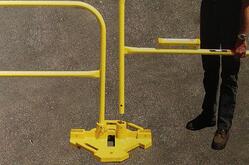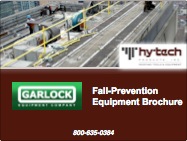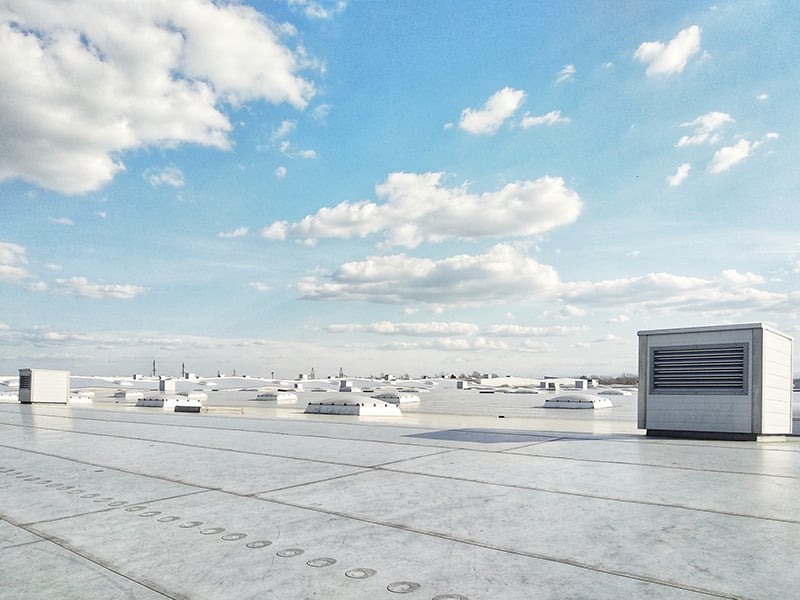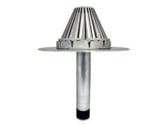OSHA requires that leading edges, skylights and other open spaces where falls may occur be guarded by fall protection systems. The Garlock RailGuard 200 Rail System provides this OSHA-compliant fall protection without drilling into the roof surface.
In this post, we walk you step-by-step through the process of installing a Garlock RailGuard 200 system around any fall hazard.
 RailGuard 200 Components
RailGuard 200 Components
The standard RailGuard 200 is made up of the following components:
- Base plate (90 lbs.)
- Rail section: 42 in. tall, and 5-, 7.5- or 10-ft. long
- Quick pins to secure the rail to the base plate
The number of base plates, rail sections and quick pins are purchased based on the length required by your project.
 Also, it is recommended you invest in the RailGuard 200 Base Transporter (pictured right). This two-wheel dolly is designed to help contractors easily move the 90-lb. base plates around the roof deck to the desired location. This post assumes you are using the Base Transporter, or an equivalent dolly.
Also, it is recommended you invest in the RailGuard 200 Base Transporter (pictured right). This two-wheel dolly is designed to help contractors easily move the 90-lb. base plates around the roof deck to the desired location. This post assumes you are using the Base Transporter, or an equivalent dolly.
PLEASE NOTE: While assembling the RailGuard 200, all workers must be tied off to an OSHA-approved fall arrest system.
Assemble the RailGuard 200 Fall Protection System
These steps will help you assemble the RailGuard 200 quickly and easily with a Base Transporter (sold separately).
1. Identify where you want to start your RailGuard 200, and then use the Base Transporter to position your first base plate on that spot.

2. Depending on the size of your railing, use the base transporter to position another base 5, 7.5 or 10 ft. from the original base. Each base plate has two railing-holder receptacles, which the RailGuard 200 railing posts slide into. These receptacles should align with the direction your railing will travel.
3. Slide the two railing posts into the corresponding base-plate receptacles. The railing posts should easily slide into position. If not, you may need to reposition the base plate slightly, or wiggle the railing around till it drops in place.
 4. Insert the quick pins through the two holes on the base plate. Each railing post has corresponding holes, which should line up if the railing is properly installed and the railing receptacles are perfectly in line with the other base plate. If not, you may need to pivot one base plate side to side to get the holes to line up.
4. Insert the quick pins through the two holes on the base plate. Each railing post has corresponding holes, which should line up if the railing is properly installed and the railing receptacles are perfectly in line with the other base plate. If not, you may need to pivot one base plate side to side to get the holes to line up.
5. Each quick pin comes with a second pin chained to it. Slide this second pin through the hole in the quick pin, after it’s been inserted through the base plate and railing holes. The second pin keeps the quick pin from coming loose.
6. Position the next base plate the proper distance away from the positioned base plate, and then install the next railing using steps 3-5.
Continue this process until you’ve completed the edge of the railing. When you come to a corner, position the next base plate at a 90-degree angle. The base plate has quick pin holes for these angles as well.
 If the railing system you are installing has one or more open ends—as may be the case if you are only installing a railing along one edge of a roof—you’ll need to attach a 5-ft. section to all open ends at a 90-degree angle (see right). This U-shaped perimeter gives your RailGuard 200 the ability to withstand a 200 lb. continuous impact—keeping it in line with OSHA regulations.
If the railing system you are installing has one or more open ends—as may be the case if you are only installing a railing along one edge of a roof—you’ll need to attach a 5-ft. section to all open ends at a 90-degree angle (see right). This U-shaped perimeter gives your RailGuard 200 the ability to withstand a 200 lb. continuous impact—keeping it in line with OSHA regulations.
If you need more information about RailGuard 200 assembly, please contact Hy-Tech Products, Inc. at 800-635-0384 or info@hy-techroof.com.

Garlock Fall-Prevention Equipment Brochure
Garlock safety equipment is built to provide rock-solid fall-protection for your crews. Learn about their perimeter guardrails, warning line systems, skylight and hatch kits, and fall-protection carts. Download Hy-Tech's Garlock Fall-Prevention Brochure to learn more.





